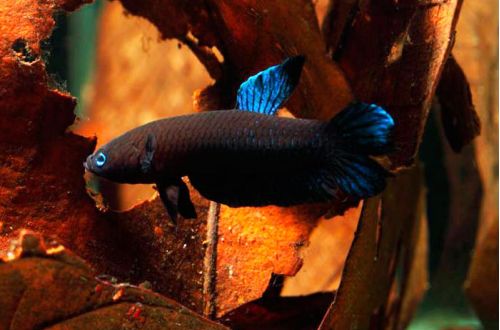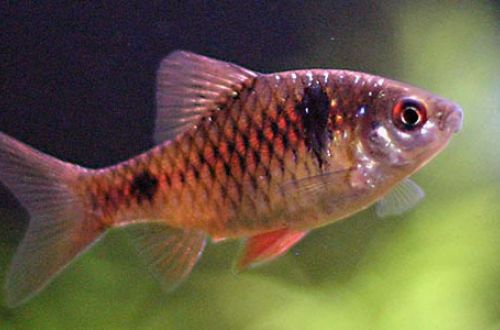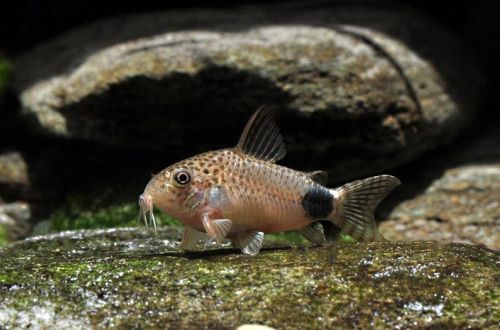
betta persephone
Betta Persephone or Cockerel Persephone, scientific name Betta persephone, belongs to the Osphronemidae family. The fish is named after the ancient Greek goddess Persephone, Queen of the Underworld, alluding to the dark coloration of her body. The maintenance of these fish is associated with the need to maintain very low values of hydrochemical parameters, which can cause difficulties for beginner aquarists. Not recommended for beginners.

Contents
Habitat
It comes from Southeast Asia from the territory of Peninsular Malaysia from the southern province of Johor. Inhabits shallow peat bogs located among tropical rainforest. Reservoirs are poorly lit. The bottom is littered with a thick layer of plant organic matter (leaves, branches), due to the decomposition of which the water has acquired a rich brown color.
Brief information:
- The volume of the aquarium – from 40 liters.
- Temperature – 22-28°C
- Value pH — 4.0–6.0
- Water hardness – 1–5 dGH
- Substrate type – any dark
- Lighting – subdued
- Brackish water – no
- Water movement – little or no
- The size of the fish is about 3 cm.
- Food – preferred food for labyrinth fish
- Temperament – peaceful
- Content alone, in pairs or in a group
Description
Adult individuals reach a length of about 3 cm. The fish has an elongated flexible body. The coloration is dark almost black. The fins and tail have bright blue hues. Sexual differences appear during the breeding season. The male retains his colors, while the female turns noticeably paler, and dark stripes appear on the sides.
Food
In nature, it feeds on small crustaceans and other invertebrates. The home aquarium will accept most popular commercial foods. It is recommended to use special products for fighting fish, produced by many manufacturers, containing all the necessary vitamins and minerals.
Maintenance and care, arrangement of the aquarium
The optimal size of the aquarium for one or two fish starts from 40 liters. When keeping Betta Persephone, it is important to recreate an environment similar to that in which a fish lives in nature. This applies to both the design and the composition of the water. In many ways, both factors are interrelated. The main elements of the decor are a dark substrate, driftwood, shade-loving aquatic plants, including floating ones. It is considered useful to add dry leaves of some trees, after swelling in water, they will sink to the bottom. During their decomposition, processes similar to those that occur in natural reservoirs will begin to occur. The leaves will become a source of tannins, giving the water its characteristic chemical composition and giving it a dark tint. Read more in the article “Which tree leaves can be used in an aquarium.” If breeding is planned, then you can add a few decorative items in the form of caves, grottoes, or ordinary ceramic pots turned on their side, or pieces of PVC pipes. All this will serve as a potential spawning site.
The main purpose of maintenance is to maintain the water environment within acceptable temperature ranges and hydrochemical values. To do this, they carry out mandatory minimum procedures for the removal of organic waste (remains of food, excrement), weekly replace part of the water (15–20% of the volume) with fresh and preliminary water treatment before adding to the aquarium. The last process is very important, because the fish need very acidic and soft water. Equally important is the placement of the necessary equipment, primarily the filtration system.
Behavior and Compatibility
By their nature, they tend to show territorial behavior, especially males, but with a sufficient number of places for shelter (the same thickets of plants) and a spacious aquarium, they get along well with each other. However, in a small tank should be maintained singly or in pairs. Compatible with other peaceful fish of comparable size.
Breeding / breeding
In favorable conditions, spawning occurs regularly. With the onset of the mating season, the male begins to build a foam-air nest with pieces of garbage (plant fragments) in any suitable place. This may be the already mentioned shelters or the lower surface of the sheet. During the construction, the male drives away from her everyone who may be a potential danger, even the female. When everything is over, courtship begins, by which time the female usually has time to change color, becoming less bright. Spawning takes place in the immediate vicinity of the nest and is accompanied by a “hug dance” when the fish are closely intertwined with each other. The female releases one egg at a time and after fertilization it is placed in the nest. In total, the clutch can contain from 20 to 50 eggs. At the end of spawning, the female swims away, and the male remains to protect future offspring.
Fish diseases
The cause of most diseases is unsuitable conditions of detention. A stable habitat will be the key to successful keeping. In the event of symptoms of the disease, first of all, the quality of the water should be checked and, if deviations are found, measures should be taken to correct the situation. If symptoms persist or even worsen, medical treatment will be required. Read more about symptoms and treatments in the Aquarium Fish Diseases section.





